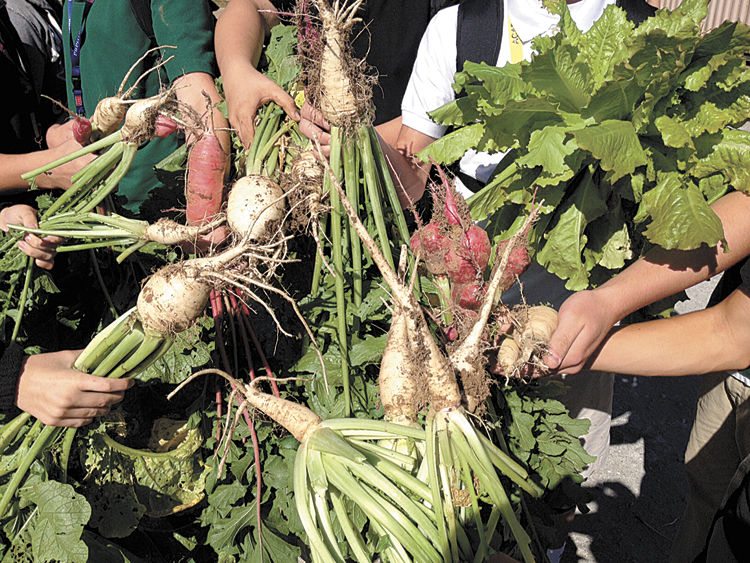Schools That Grow
Published 10:28 am Friday, August 21, 2015

- Schools That Grow
By Amanda Jean Harris / Submitted Photos
Meat processing may not sound like a particularly grand endeavor or one that falls in line with a revolutionary approach to the classroom. And yet, at one Lafayette school it is just one example of how the Farm to School initiative is benefiting students in many areas of life and education.
br
At Acadiana High School, Brandon Broussard teaches agriscience to students where he incorporates Farm to School in everyday curriculum. In meat processing lessons, everything from produce to meat is covered, the students had to opportunity to create their own seasoning blend and design the label. Students are learning everything from measuring to graphics, which connects with the arts department, and math lessons.
br
br
The Movement
br
“We have a pretty good movement in our state,” Broussard says. When looked at from every angle, the Farm to School movement is something that is perhaps older that even our organized schools. Like many things of benefit that seem to fall out of vogue, people nationwide are recognizing the value of Farm to School and the concept seems to have come full circle.
br
The move to connect education and agriculture is making leaps and bounds. Evidenced by the state’s first ever conference held this May in Baton Rouge hosted by the LSU AgCenter. The Farm to School Conference was made possible by a grant at the national level and is the first statewide event of its kind. It was geared toward practitioners and anyone in the state that is working on or has an affiliation with Farm to School. Think school program coordinators, teachers, support organizations, child nutrition directors and the like.
br
Katie Mularz of the Louisiana Farm to School Alliance, which was formed in 2012, said there are three basics to the movement and the conference. “Three core elements: gardening, education and procurement,” Mularz says. She says it can be anything from a child nutrition director who is infusing local food through taste tests for students or snacks or meals to the growers and producers working to get farm food into the schools.
br
By the first of August two more meetings across the state had taken place in Alexandria and Baton Rouge with education for stakeholders. In Central Louisiana a “Foodapolooza” will center on local farms. A new initiative to fund any sort of Farm to School project has just come to a close with more on the horizon. “We just closed our Seed Change Project,” Mularz says. “It was the first competitive Farm to School grant in the state. Our hope is to have continued funding for competitive grants. There was a $5,000 mini grant program on lousianafarmtoschool.org with a resources tab that patches through for resources to the national network.”
br
br
The Network
br
The Farm to School concept is an age old one that seems to have just recently been named and understood by some. It covers a wide berth of programs and concepts — the lessons learned on the farm are infused into every area of learning, students creating their own gardens on campus to feed fellow students, local farmers providing produce for the cafeteria.
br
“We are a very young network,” Mularz says. “But the concept of Farm to School is not young by any means.” For years, there have been connection points between schools and farms. The collaboration has been the missing component. There has never been a central hub for these connections, until now. There was no lack of farmers or schools in need.
br
“That’s where the need was and it’s why the alliance was formed in 2012,” Mularz says. “A group of individuals and organizations that identified a need for a collaborative effort to spread Farm to School in the state. It’s made up of more than 125 organizations in the state in food, farm, nutrition and education with a shared vision to build a dialogue for Farm to School and build resources.”
br
Mularz says that the alliance is the umbrella for it all. The Seed Change Project is part of the program and the recipients will be announced within weeks. A national Farm to School network is the information and resource hub for the movement at an even higher level and state agencies are on board as well. “We work with state agencies that are extremely supportive — DHH, Department of Education and Agriculture with the land grand institution, which is at LSU and other universities as well.”
br
In Acadiana, Mularz points to Lafayette Parish where schools host programs like those Broussard leads along with Iron Chef-like competitions between students and chefs using local foods. She also commends the Lafayette Parish School Garden Initiative and Child Nutrition Program. In Calcasieu, St. Landry and St. James, a handful of elementary schools have started school gardens as well.
br
There are plenty more schools taking similar initiatives. Some of them never label themselves as Farm to School, which is part of what the alliance does — program articulation. “Folks are doing Farm to School and not labeling it that. We are helping not just support those who are doing Farm to School but being able to identify that you are doing it,” Mularz says.
br
Articulating and identifying who has already begun the implementation of Farm to School means more support for those who have already dug in. While education from any angle seems to have a full plate, Mularz notes the intrinsic nature of Farm to School to be infused rather than added to existing programs. “Farm to School is not an additional program. It can fit into the existing coursework depending on the school culture. It’s supportive of student achievement. I see Farm to School as a supportive tool to accomplish the school’s mission. It’s up to the school to determine where they want to infuse that support. How can Farm to School support academics without adding to existing workload? How can it be used as a resource and a tool to help achieve within the school?”
br
Teachers like Broussard seem to have answered these questions. “It’s all very practical,” he says. “There are a lot of lessons associated with this.”





